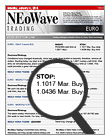The same way calculus elevated mathematics beyond algebra and trigonometry, the logical, self-defining limits and self-confirming aspects of NEoWave raise the field of wave analysis above the realm of speculation and opinion and into the realm of science and fact.
The three core elements of Elliott Wave are:
- the Fibonacci number series
- pattern recognition
- the Golden ratio (.618)
All three elements have a "forecasting" or "anticipatory" aspect, in which the analyst is expecting the market to move up or down a certain number of "waves," which adhere to a predictable design and have specific relationships.
The three core elements of NEoWave are:
- Logic (for example, a strong correction must yield a powerful move)
- Self-defining (a smaller degree pattern cannot take more time and price than a larger degree pattern)
- Self-confirming (strict requirements for post-pattern market behavior to determine whether your prior structural analysis was correct)
Because orthodox Elliott Wave lacks these advanced, NEoWave concepts, traditional Elliott Wave analysts frequently find themselves unable to determine which of multiple, contradictory wave counts, is the correct scenario.
For example, in 1988, Glenn Neely was one of the only bullish analysts in the world. At that time, many orthodox Elliott Wave practitioners were extremely bearish (and have remained that way to the present). On the other hand, Glenn Neely's bullish, long-term forecast stood alone and was heavily ridiculed. It was the logic of NEoWave that allowed Glenn Neely to remain so adamantly and confidently bullish on the U.S. stock market, even in the face of overwhelming, negative national and international news.
Later, it was NEoWave that allowed Glenn Neely to turn adamantly bearish on the U.S. stock market near the highs of 2000 and then, two years later, turn bullish again just six months after the 2002 low. Finally, in January of 2008 – once again, despite strong opposition – he turned adamantly bearish on the U.S. stock market. It was NEoWave that gave Glenn Neely the courage to announce in mid-January 2008 that a new bear market began and that there was virtually nothing that could be done to stop the downward, economic spiral wrought by the U.S. stock market for the next 4 to 6 years.
In its orthodox form, Elliott Wave never allows for such dogmatic forecasts. To the contrary, Elliott Wave typically generates multiple, completely contradictory scenarios. The simultaneous existence of bullish and bearish counts is of little value to traders.
With its step-by-step, logical approach, Glenn Neely's NEoWave has transformed –
revolutionized – Elliott Wave. What began as R.N. Elliott's intriguing theory is now a more comprehensive and accurate market analysis and forecasting system.
Learn More: How does NEoWave and Elliott Wave differ?




